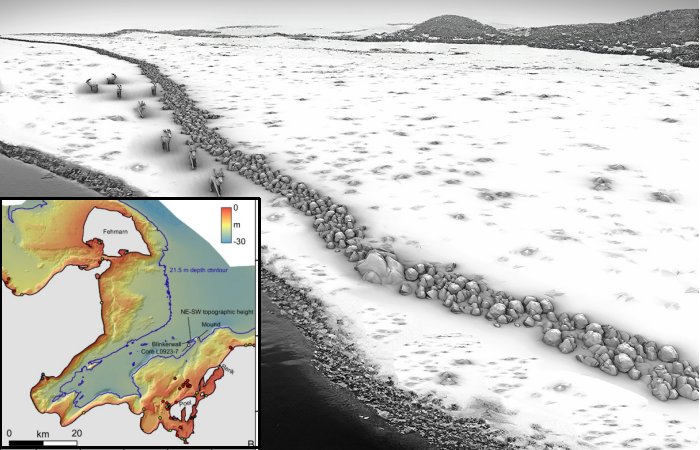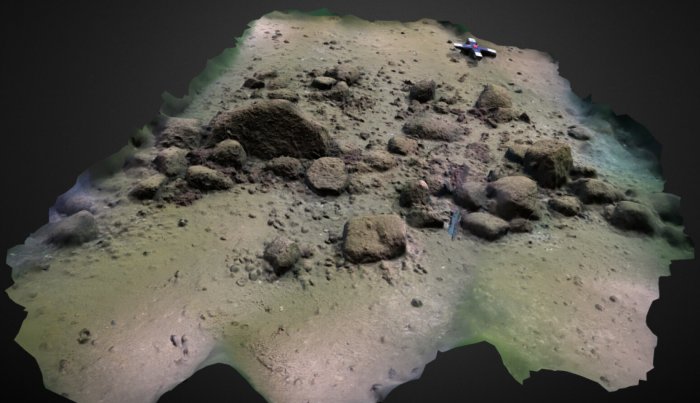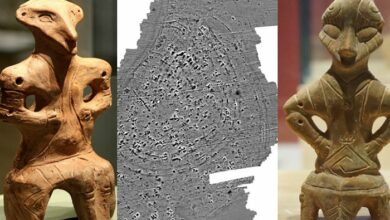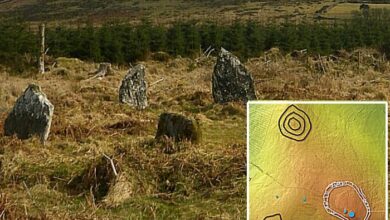Underwater Drone Images Reveal Oldest Human-Made Structure In The Baltic Sea

Conny Waters – AncientPages.com – While conducting a mineral survey on the Baltic Sea floor, scientists stumbled upon an unanticipated discovery that provided evidence of early European hunting techniques.
Their acoustic imaging technology unveiled a submerged stone wall that extended nearly a kilometer in length. Further exploration using underwater drones revealed that this wall was composed of over 1,500 stones, primarily granite pieces roughly the size of tennis or soccer balls.
Stones, predominantly the size of tennis and soccer balls, extend for nearly one kilometer under the Baltic Sea, as shown in this digital model, based on 3D scanning data. Credit: Michał Grabowski
Preliminary research suggests that Stone Age hunter-gatherers probably constructed this structure approximately 11,000 years ago for reindeer hunting. This discovery marks the first instance of a Stone Age hunting structure being found in the Baltic Sea region.
The ancient wall situated at the base of Mecklenburg Bight, approximately 10 kilometers away from Rerik, is submerged under a water depth of 21 meters. It is composed of stones that are aligned so regularly that it is improbable for it to have formed naturally.
“Our investigations indicate that a natural origin of the underwater stone wall as well as a construction in modern times, for instance, in connection with submarine cable laying or stone harvesting are not very likely. The methodical arrangement of the many small stones that connect the large, non-moveable boulders speaks against this,” explains Jacob Geersen, lead author of the study.
Structures of a similar nature and age have been discovered globally – submerged deep under Lake Huron, scattered across the high Arctic, and the so-called “desert kites” located in the arid landscapes of Jordan and Saudi Arabia.
Excluding natural processes and recent formation, the stone wall’s existence can only be traced back to the period following the last ice age. This was a time when the Baltic Sea had not yet submerged the landscape.
“At this time, the entire population across northern Europe was likely below 5,000 people. One of their main food sources were herds of reindeer, which migrated seasonally through the sparsely vegetated post-glacial landscape. The wall was probably used to guide the reindeer into a bottleneck between the adjacent lakeshore and the wall, or even into the lake, where the Stone Age hunters could kill them more easily with their weapons,” explains Marcel Bradtmöller from the University of Rostock.
The study area in the Baltic Sea. Location and relative ages of submerged archaeological sites are taken from http://www.splashcos.org. (A) Overview map of the Western Baltic Sea. Bathymetric data were taken from the Global Multi-Resolution Topography (GMRT) synthesis (3). (B) Detailed structure of the Bay of Mecklenburg including the location of the Blinkerwall. Bathymetric data from The Federal Maritime and Hydrographic Agency Bundesamt für Seeschifffahrt und Hydrographie (BSH). Credit: Proceedings of the National Academy of Sciences (2024). DOI: 10.1073/pnas.2312008121
The last reindeer herds vanished from these regions approximately 11,000 years ago due to climate warming and forest expansion. Consequently, the stone wall was probably not constructed after this period. If this is accurate, it would classify the wall as the oldest human-made structure ever found in the Baltic Sea.
“Although numerous well-preserved archaeological sites from the Stone Age are known from the Bay of Wismar and along the coast of Mecklenburg-Vorpommern, these are located in much shallower water depths and mostly date to the Mesolithic and Neolithic periods (approx. 7,000–2,500 BC),” explains Jens Auer from the Mecklenburg-Vorpommern State Office for Culture and Monument Preservation (LAKD M-V), who was involved in the exploration and sampling of many of these sites.
3D model of a section of the Blinkerwall adjacent to the large boulder at the western end of the wall. Credit: Philipp Hoy, Rostock University, Agisoft Metashape by J. Auer, LAKD M-V.
The stone wall will now be investigated using side-scan sonar, sediment echo sounder, and multibeam echo sounder devices.
Luminescence dating, a technique that ascertains the last time a stone surface was exposed to sunlight, could aid in pinpointing a more accurate construction date for the stone wall. Additionally, the researchers plan to recreate the ancient landscape surrounding it.
See also: More Archaeology News
The research can provide substantial insights into the lifestyle, societal structures, and hunting techniques of early Stone Age hunter-gatherers.
The study was published in the journal Proceedings of the National Academy of Sciences
Written by Conny Waters – AncientPages.com Staff Writer







